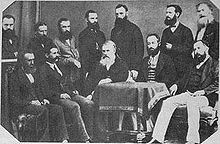- Henry Benedict Medlicott
-
Henry Benedict Medlicott (3 August 1829 - 6 April 1905) was an Irish geologist who worked in India.
Early life
He was born in Loughrea, County Galway, Ireland, the son of the Church of Ireland Rector of Loughrea, Samuel Medlicott (1796–1858) and his wife Charlotte (c.1814-1884), daughter of Henry Benedict Dolphin, C. B. He was educated at Trinity College, Dublin as well as in France, Guernsey, and Dublin. He obtained a BA in 1850 with diploma in honours in the School of Civil Engineering and an MA in 1870. He was an expert in French and was acquainted with the works of the French geologists.[1]
Career and later life
He joined the Geological Survey of Ireland in 1851 and in 1853 joined the British Geological Survey working with Mr Aveline in Wiltshire. He was later engaged by Dr. Thomas Oldham and joined the Indian Geological Survey that was working in the Rajmahal Hills near Bhagalpur. In August 1854 left England for India where he became professor of geology at the University of Roorkee and remained there until October 1862. While at Roorkee, he studied parts of the Narmada Valley and Bundelkhand (in 1854-55, 1856–57). He worked on the geology of the Lower Himalayas and the Siwalik Beds. In 1857 he served as a volunteer with the garrison of Roorkee against the mutineers and was awarded the Indian Mutiny Medal for Special Service.
On October 27, 1857 he married Louisa Maunsell in Landour. Louisa was the daughter of the Reverend Daniel Henry Maunsell, Vicar of Balbriggan, County Dublin. He has had three sons and three daughters.
He worked initially with his brother Joseph G. Medlicott and his first achievement was in separating the Cambrian Vindhyan region from the Gondwana. He worked in various parts of the country such as South Rewa, Bihar, Assam, Khasi Hills, Rajputana, Kashmir, the Satpura ranges and the Garo Hills. On 1 April 1876 he succeeded Dr Oldham to head the Department of Geology and was posted in Calcutta. The position was changed from Superintendent to Director in 1885. He is credited with having suggested the name Gondwana for the supercontinent in the year 1872.[2]
He was elected a Fellow of the Royal Society in 1877 and won the Wollaston Medal of the Geological Society in 1888. He was a Fellow of Calcutta University, and from 1879 to 1881 he was President of the Asiatic Society of Bengal. His obituarist Blanford notes that he never used "FRS" after his name in any publications.[1]
He wrote Manual of the Geology of India with William Thomas Blanford in 1879 as well as edited works in the Paleontologica Indica.
References
- ^ a b Blanford, W. T (1907) Obituary Notices of Fellows Deceased. Proceedings of the Royal Society of London. Series B, Containing Papers of a Biological Character. 79(535):i-xxxvii+xxxviii-lxiii. (This obituary is accompanied by the obituary of the author)
- ^ DeWit, M., M. Jeffrey, H. Bergh, and L. Nicolaysen. 1999. “Gondwana reconstruction and dispersion.” Search and Discovery Article 30001. American Assoc. of Petroleum Geologists.
Categories:- People from County Galway
- Alumni of Trinity College, Dublin
- Fellows of the Royal Society
- Irish geologists
- Wollaston Medal winners
- 1829 births
- 1905 deaths
Wikimedia Foundation. 2010.

